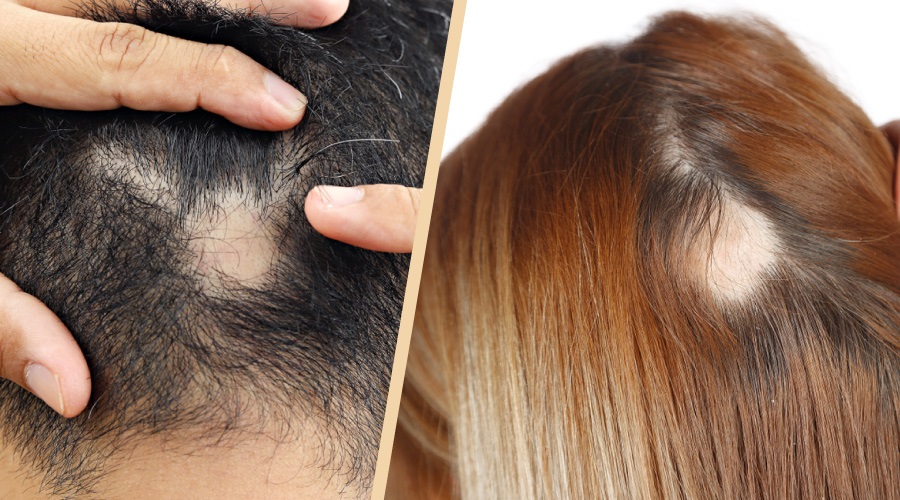Hair loss, scientifically termed alopecia, is a condition that affects millions globally and can be a source of significant distress. Far more complex than simple shedding, alopecia encompasses a range of conditions, each with distinct causes, patterns, and prognoses. Understanding the specific hair loss reasons is the first, crucial step toward effective management and finding appropriate solutions.
What is Alopecia? Defining the Different Types
Alopecia is the general medical term for hair loss. It’s categorized based on whether the hair follicle is permanently destroyed (scarring alopecia) or potentially reversible (non-scarring alopecia).
1. Androgenetic Alopecia (Pattern Hair Loss)
This is the most common cause of hair loss, affecting up to 50% of men and women.
- Reason: It is primarily genetic, involving a sensitivity to dihydrotestosterone (DHT), a hormone derivative of testosterone. DHT shortens the hair growth cycle, causing the follicles to shrink and produce finer, shorter hairs until the follicle eventually becomes dormant.
- Pattern: In men, it presents as a receding hairline and thinning crown (M-shaped pattern). In women, it typically involves diffuse thinning over the top of the scalp, sparing the hairline.
2. Alopecia Areata (Autoimmune Hair Loss)
This type is characterized by patchy hair loss and is classified as an autoimmune disorder.
- Reason: The body’s immune system mistakenly attacks the hair follicles, interrupting the hair growth cycle. The exact trigger is often unknown but is sometimes linked to stress, viral infections, or other autoimmune conditions.
- Pattern: It presents as smooth, round, coin-sized patches of hair loss on the scalp or body. In rare cases, it can progress to total loss of scalp hair (alopecia totalis) or total body hair (alopecia universalis).
3. Telogen Effluvium (Stress-Related Shedding)
This is a temporary condition characterized by widespread thinning across the scalp.
- Reason: It occurs when a sudden, severe physiological or emotional “shock” forces a large percentage of growing hairs prematurely into the resting (telogen) phase. The trigger event causes the hair to shed approximately three months later.
- Common Triggers: Significant physical stress (major surgery, childbirth, high fever/illness), extreme emotional stress, rapid weight loss, certain medications, or sudden dietary changes. The condition is temporary, and full hair regrowth usually occurs once the underlying cause is resolved.
Systemic and Environmental Hair Loss Reasons
Hair loss is often a visible indicator of an underlying internal imbalance or deficiency. Addressing these systemic factors is critical for recovery.
1. Hormonal Imbalances
The endocrine system plays a vast role in the hair cycle:
- Thyroid Dysfunction: Both an overactive (hyperthyroidism) and underactive (hypothyroidism) thyroid gland can cause diffuse hair thinning. Thyroid hormones regulate numerous metabolic processes, including those controlling hair growth.
- Polycystic Ovary Syndrome (PCOS): In women, this condition can cause an elevation in male hormones (androgens), leading to thinning hair on the scalp alongside other symptoms like acne and excess facial hair.
2. Nutritional Deficiencies
A poor diet or malabsorption issues can deprive follicles of the necessary building blocks:
- Iron Deficiency (Anemia): Iron is vital for the production of hair cell protein. Low iron levels are a common, correctable cause of hair shedding, particularly in women.
- Protein and Essential Fatty Acids: Severe or prolonged protein restriction (common in crash dieting) can lead to hair loss.
- Vitamins and Minerals: Deficiencies in essential vitamins (like Vitamin D or B vitamins) and minerals (like Zinc) have been linked to hair thinning.
3. Physical Trauma and Styling (Traction Alopecia)
Hair loss isn’t always internal; external physical stress can be damaging:
- Traction Alopecia: Caused by constant, prolonged pulling force applied to the hair roots. This is commonly seen with tight hairstyles like dreadlocks, braids, cornrows, or excessively tight ponytails. If the traction is chronic, it can lead to scarring and permanent follicle damage.
- Harsh Chemical Treatments: Frequent use of high-heat styling tools, chemical relaxers, or aggressive dyes can weaken the hair shaft, leading to breakage and visible thinning.
Diagnosis and Management
Because the causes are so diverse, self-diagnosis is generally ineffective. The management of alopecia always begins with a precise diagnosis by a dermatologist or healthcare provider.
- Diagnosis: Tools often include a detailed patient history, a physical examination of the scalp, blood tests (to check for nutritional deficiencies or hormonal issues), and sometimes a scalp biopsy.
- Treatment: Management is highly dependent on the cause. It can range from addressing underlying deficiencies (supplements for iron or vitamin D), hormonal stabilization (medication for thyroid or PCOS), topical solutions (to stimulate follicles), or, in some cases of advanced pattern hair loss, surgical restoration.
In summary, alopecia is a complex condition that serves as a diagnostic window into the body’s internal state. Understanding whether the hair loss is genetic, autoimmune, or reactive to stress and internal imbalances is key to restoring not just the hair, but often overall health.

